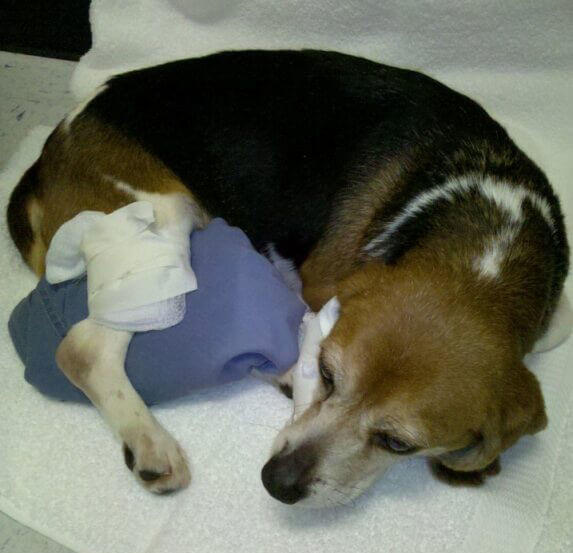UN INT Intro Text w/ Responsive Image - *Important Note* You must UNLINK this shared library component before making page-specific customizations.
Animals in laboratories are already sentenced to a life of misery and pain and an early death. But astonishingly, things can—and do—get worse.
Some animals don’t receive even a token aspirin for their suffering. Experimenters are allowed, by law, to force animals to endure radiation, weeks-long restraint, electroshocks, and more without giving them the slightest hint of sedation or pain relief.

In its annual report, the U.S. Department of Agriculture (USDA) classifies the experiments that cause thinking, feeling beings unmitigated pain or distress under what is known in laboratory lingo as “Column E.”
‘Column’ What?
Animal experimentation facilities are required to file a form justifying why animals were denied pain relief, and it need not be detailed. It could simply be that pain management interferes with the experiment’s objectives. Then, those experiments are compiled in the facility’s annual report under Column E.
That’s it. No more questions. Just move on.

This Column E is a hall pass for experimenters to inflict unmitigated pain—whether for expediency, to reduce costs, or under the misguided belief that using pain relief would interfere with the “scientific objectives” of the experiment, even though it’s well documented that withholding pain relief will do the same. And the National Institutes of Health (NIH) funds these tests with your tax dollars. We need your help to get funding for these grotesque experiments cut off.

Cats, dogs, mice, rats, cows, chickens, bats, monkeys, pigs, and many other animals are subjected to Column E experiments carried out around the country in university and government laboratories and contract research facilities. These are just a few recent examples:
Battelle Memorial Institute
- Experimenters exposed 161 rabbits to a substance that caused them pain and distress, including lethargy, respiratory distress, seizures, and death.
- Experimenters gave 32 African green monkeys a bacterial infection that caused them pain and distress, including lethargy, a hunched posture, weakness, respiratory problems, fecal problems, oral/nasal discharge, and unresponsiveness.
- Experimenters injected 26 rhesus macaques with a nerve agent causing intoxication and pain, including respiratory distress and muscle twitches.
Emergent BioDefense Operations Lansing
Experimenters used a total of 6,272 guinea pigs in studies in which they were infected with anthrax. Guinea pigs infected with anthrax may exhibit symptoms such as fever, lethargy, and difficulty breathing, leading to systemic effects, organ failure, and death.
Florida State University
Experimenters subjected 689 voles to the forced swim test and the restraint stress test. In the former, experimenters put the voles in a container of water that they couldn’t touch the bottom of or climb out of for six minutes. The stressed animals swam for their lives before becoming immobile. In the latter, experimenters stuffed voles inside narrow restraint tubes for up to an hour, causing them stress and anxiety.
Harry S. Truman Memorial Veterans’ Hospital
Experimenters applied corrosive substances to rabbits’ eyes to damage their corneas.
Harvard University
Experimenters restrained the heads of five rabbits, keeping them stock-still, during various experiments.
Johns Hopkins University
- Experimenters force-fed 16 piglets by shoving a thick plastic tube down their throats. This was repeated six times a day for five days, causing painful intestinal inflammation.
- Other experimenters injured a pig’s spinal cord, paralyzing the animal’s back legs.
NIH
Experimenters exposed eight guinea pigs to a lethal dose of a virus known to cause significant pain and distress, including difficulty breathing, fatigue, discomfort, weight loss, dehydration, and body weakness so acute that it can prevent animals from standing upright.
University of Alabama at Birmingham
Experimenters injected nerve growth factor into the lower backs of six cats to create a hypersensitive area there. They forcefully manipulated their spines while observing the animals’ facial expressions to record how they reacted to pain.
University of Massachusetts
Experimenters infected 33 guinea pigs with either diphtheria or tetanus, causing them to experience toxicity symptoms and die.
University of Michigan
Experimenters strapped five endangered long-tailed macaques into chairs, preventing them from moving their heads and arms. The monkeys were trapped this way for up to eight hours and were used in a battery of tests.
University of Texas Medical Branch–Galveston
Experimenters infected 348 guinea pigs with a compound that causes painful symptoms, including paralysis, anorexia, rashes, eye discharge, difficulty breathing, severe fever with bleeding, flu-like symptoms, and death. The compound was injected into the vagina, rectum, muscle, vein, nasal passage, or abdominal cavity of the small animals.
University of Utah
Experimenters removed a thick portion of skin from two pigs. The animals suffered for up to two weeks as their wounds healed without pain relief.
University of Washington
Experimenters subjected 20 wild squirrels to fear conditioning tests, forcing them to endure jarring electric shocks to their feet. They placed shock grids throughout the squirrels’ foraging area and delivered randomized shocks to disrupt their circadian rhythm.
USDA
Experimenters placed a leg-hold trap in a coyote’s enclosure and attracted the animal to it with bait. Leg-hold traps have a jaw-like mechanism with teeth that clamp onto legs, causing physical pain and injury, including broken bones, dislocations, deep wounds, severe stress, fear, and behavioral changes. Experimenters also let other coyotes see the trapped coyote suffer.
USDA Knipling-Bushland U.S. Livestock Insects Research Laboratory
Experimenters trapped 102 young cows in restraint devices, preventing them from moving their heads and grooming themselves to alleviate discomfort caused by ticks and insects. This restraint lasted for several weeks as experimenters used the cows’ bodies as a breeding ground for ticks and insects.
USDA Western Regional Research Center
Experimenters infected 260 mice with botulism, causing symptoms such as blurred vision, difficulty swallowing, muscle weakness, dry mouth, paralysis, and even complete respiratory failure.
Wayne State University
Experimenters subjected 184 baby rabbits to the forced swim test and the classical eye blink conditioning test. In the former, experimenters hooked the babies to harnesses and put them in a tank of water for up to a minute, forcing them to frantically swim for their lives. In the latter, experimenters restrained the babies for up to an hour and puffed air into their eyes as punishment if they didn’t blink after hearing a sound.